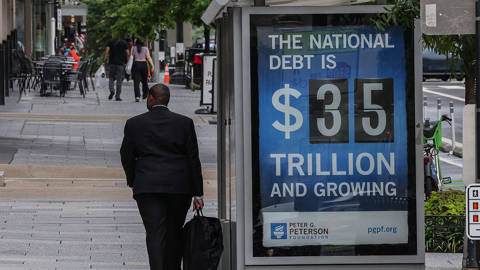The UN Climate Change Conference in Paris in December will feature all the tightly choreographed production values of a Hollywood blockbuster. But while the plot calls for the planet to be saved, the script is based mostly on fiction.
OTTAWA – The United Nations Climate Change Conference in Paris in December will feature all the tightly choreographed production values of a Hollywood blockbuster. The cast will be huge: presidents and prime ministers at center stage, supported by thousands of extras, including protesters, riot police, and busloads of media. The script may still be under wraps, but the plot has already leaked: This time, in sharp contrast to the failed negotiations in Copenhagen in 2009, the planet is going to win.
It is a seductive plot, but one that does not quite hold together. Goodwill and hard bargaining, the world will be told, paid off. Governments have agreed to voluntary reductions in greenhouse-gas emissions that will prevent the planet from heating more than 2° Celsius. Then, in a stunning deus ex machina, it will be revealed that the world’s largest fossil-fuel companies – the so-called supermajors – have agreed to bring net emissions to zero by 2100, by capturing carbon at the source, sucking it out of the atmosphere, and storing it underground. The planet will have been saved, and the economy will be free to flourish. Cue the music and roll the credits.
The trouble is that the script is fiction, not documentary. The technology required has yet to be invented, and bringing net emissions to zero simply is not possible. And, like a Hollywood production, the Paris conference’s message will have been heavily influenced by those who have the most money.
The math is not difficult to follow. The world’s energy infrastructure – finely tooled for the use of fossil fuels – is worth $55 trillion. The paper value of the fossil-fuel reserves – most of them owned by the supermajors – is some $28 trillion.
The fossil-fuel industry’s influence is evident in the fact that governments worldwide are expected to spend some $5.3 trillion this year subsidizing it, including the massive outlays necessary to counteract its adverse health and environmental effects. In other words, the governments meeting in Paris spend more subsidizing the causes of climate change than they do on global health care or, for that matter, on climate-change mitigation and adaptation.
But that will not be part of the story in Paris. There, the global public will be presented with a narrative premised on two unproven forms of “geoengineering,” proponents of which seek to manipulate the planetary system. The effort that will receive the greatest amount of attention is bio-energy with carbon capture and storage (BECCS). In May, the United States Department of Energy convened a private meeting to discuss this technology, which will be the fig leaf used by the supermajors to protect their assets.
Deploying BECCS, however, would require the world to maintain an area 1.5 times the size of India, full of fields or forests capable of absorbing vast amounts of carbon dioxide, while still providing enough food for a global population that is expected to exceed nine billion by 2050. By then, the technology’s advocates promise, biological sequestration will be joined by programs that capture emissions as they are released or pull them out of the air to be pumped into deep subterranean shafts – out of sight and out of mind.
Fossil-fuel producers promote carbon capture to allow them to keep their mines open and pumps flowing. Unfortunately for the planet, many scientists consider it technically impossible and financially backbreaking – especially if such technology is to be deployed in time to avert chaotic climate change.
Preventing temperatures from rising out of control will require a second geoengineering fix, known as solar radiation management. The idea is to mimic the natural cooling action of a volcanic eruption, by using techniques like the deployment of hoses to pump sulfates 30 kilometers into the stratosphere to block sunlight.
The United Kingdom’s Royal Society believes that the need for such technology may be unavoidable, and it has been working with counterparts in other countries to explore ways in which its use should be governed. Earlier this year, the US National Academies of Science gave the technique a tepid endorsement, and the Chinese government announced a major investment in weather modification, which could include solar radiation management. Russia is already at work developing the technology.
Unlike carbon capture, obstructing sunlight actually has the potential to lower global temperatures. In theory, the technology is simple, cheap, and capable of being deployed by a single country or a small group of collaborators; no UN consensus is required.
But solar radiation management does not remove greenhouse gases from the atmosphere. It only masks their effects. If the hoses shut down, the planet’s temperature will soar. The technology could buy time, but it surrenders control of the planetary thermostat to those who hold the hoses. Even the technology’s advocates concede that their computer models predict that it will have a strong negative impact on tropical and subtropical regions. Climate change is bad, but geoengineering has the potential to make it worse.
The story that the Paris conference’s producers will ask viewers to believe relies on technologies that are no more effective than smoke and mirrors. It is important that we learn to see past them. The curtain will rise on a set of false promises, and it will close with policies that can lead only to mayhem – unless the audience gets into the act.











OTTAWA – The United Nations Climate Change Conference in Paris in December will feature all the tightly choreographed production values of a Hollywood blockbuster. The cast will be huge: presidents and prime ministers at center stage, supported by thousands of extras, including protesters, riot police, and busloads of media. The script may still be under wraps, but the plot has already leaked: This time, in sharp contrast to the failed negotiations in Copenhagen in 2009, the planet is going to win.
It is a seductive plot, but one that does not quite hold together. Goodwill and hard bargaining, the world will be told, paid off. Governments have agreed to voluntary reductions in greenhouse-gas emissions that will prevent the planet from heating more than 2° Celsius. Then, in a stunning deus ex machina, it will be revealed that the world’s largest fossil-fuel companies – the so-called supermajors – have agreed to bring net emissions to zero by 2100, by capturing carbon at the source, sucking it out of the atmosphere, and storing it underground. The planet will have been saved, and the economy will be free to flourish. Cue the music and roll the credits.
The trouble is that the script is fiction, not documentary. The technology required has yet to be invented, and bringing net emissions to zero simply is not possible. And, like a Hollywood production, the Paris conference’s message will have been heavily influenced by those who have the most money.
The math is not difficult to follow. The world’s energy infrastructure – finely tooled for the use of fossil fuels – is worth $55 trillion. The paper value of the fossil-fuel reserves – most of them owned by the supermajors – is some $28 trillion.
The fossil-fuel industry’s influence is evident in the fact that governments worldwide are expected to spend some $5.3 trillion this year subsidizing it, including the massive outlays necessary to counteract its adverse health and environmental effects. In other words, the governments meeting in Paris spend more subsidizing the causes of climate change than they do on global health care or, for that matter, on climate-change mitigation and adaptation.
But that will not be part of the story in Paris. There, the global public will be presented with a narrative premised on two unproven forms of “geoengineering,” proponents of which seek to manipulate the planetary system. The effort that will receive the greatest amount of attention is bio-energy with carbon capture and storage (BECCS). In May, the United States Department of Energy convened a private meeting to discuss this technology, which will be the fig leaf used by the supermajors to protect their assets.
BLACK FRIDAY SALE: Subscribe for as little as $34.99
Subscribe now to gain access to insights and analyses from the world’s leading thinkers – starting at just $34.99 for your first year.
Subscribe Now
Deploying BECCS, however, would require the world to maintain an area 1.5 times the size of India, full of fields or forests capable of absorbing vast amounts of carbon dioxide, while still providing enough food for a global population that is expected to exceed nine billion by 2050. By then, the technology’s advocates promise, biological sequestration will be joined by programs that capture emissions as they are released or pull them out of the air to be pumped into deep subterranean shafts – out of sight and out of mind.
Fossil-fuel producers promote carbon capture to allow them to keep their mines open and pumps flowing. Unfortunately for the planet, many scientists consider it technically impossible and financially backbreaking – especially if such technology is to be deployed in time to avert chaotic climate change.
Preventing temperatures from rising out of control will require a second geoengineering fix, known as solar radiation management. The idea is to mimic the natural cooling action of a volcanic eruption, by using techniques like the deployment of hoses to pump sulfates 30 kilometers into the stratosphere to block sunlight.
The United Kingdom’s Royal Society believes that the need for such technology may be unavoidable, and it has been working with counterparts in other countries to explore ways in which its use should be governed. Earlier this year, the US National Academies of Science gave the technique a tepid endorsement, and the Chinese government announced a major investment in weather modification, which could include solar radiation management. Russia is already at work developing the technology.
Unlike carbon capture, obstructing sunlight actually has the potential to lower global temperatures. In theory, the technology is simple, cheap, and capable of being deployed by a single country or a small group of collaborators; no UN consensus is required.
But solar radiation management does not remove greenhouse gases from the atmosphere. It only masks their effects. If the hoses shut down, the planet’s temperature will soar. The technology could buy time, but it surrenders control of the planetary thermostat to those who hold the hoses. Even the technology’s advocates concede that their computer models predict that it will have a strong negative impact on tropical and subtropical regions. Climate change is bad, but geoengineering has the potential to make it worse.
The story that the Paris conference’s producers will ask viewers to believe relies on technologies that are no more effective than smoke and mirrors. It is important that we learn to see past them. The curtain will rise on a set of false promises, and it will close with policies that can lead only to mayhem – unless the audience gets into the act.